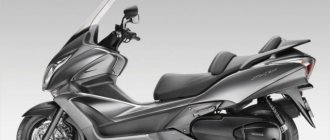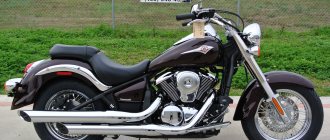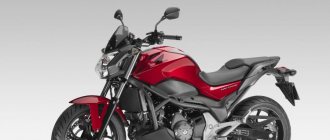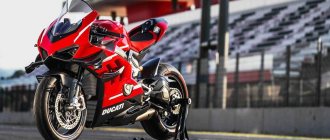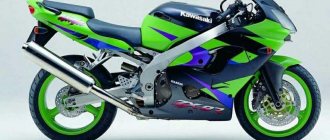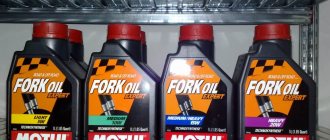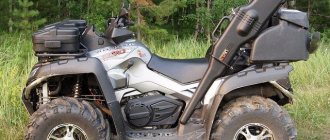Mileage is not the main thing
This short and succinct fact will require explanation, but the main idea can be conveyed literally in a nutshell: it is not the remaining life of the engine “up to capital” that is important, what is important is the condition of the entire motorcycle, which is influenced not by the mileage traveled, but by operating and storage conditions. Externally, an almost new bike may look “A”, sparkling with a pleasant number on the odometer, and its engine, meanwhile, will have liters of oil. Or vice versa - a 20-year-old shabby "classic" with mileage well over 50 thousand will be very cheerful "inside". The difference is that in the first case, the motorcycle was driven at maximum speed, without thinking about maintenance, and in the second, it was taken care of, riding in the recommended mode, and did not skimp on good consumables. Before making an unambiguous choice regarding the motorcycle you are interested in, find the answer to several questions: who rode it, how much, and on what roads, how was it maintained, where was it stored?
Too rare motorcycle
What does every person strive for? Towards uniqueness.
Oh, those happy faces of the owners when someone proudly declares that there are only two such motorcycles in this city, one of them is in front of you! Hence, there are so many individual orders, customizations and all sorts of alterations, from boosting the engine to airbrushing and replacing the rear light. Motorcyclists go to great lengths to stand out from the crowd! The logic in this case is simple, as in films about street racing, when a newcomer arrives at the starting point in his grandfather’s Mustang, he is unlikely to take first place without experience, but the audience award is certainly in his pocket.
A rare motorcycle for a first-season rider is a bad idea due to problems finding consumables. While others are hauling bags of spare parts from motorcycle clubs or removing nuts from donors, you will have to search for a rare model throughout the entire season.
Secondly, few people can really advise anything from their own experience. The rarer the motorcycle, the fewer people who have dealt with it. Any breakdown will have to be fixed using the collected bits of information from rare users.
How does the type of motorcycle affect its survivability?
The golden rule: “the larger the cubic capacity of the engine, the greater the service life”, with regard to two-wheeled vehicles, 90 percent is true, the rest depends on the type and timing of the engine, as well as the category of the bike itself. A large “tourist” with a low-speed engine can boast 10 times more mileage than any of the motocross motorcycles, despite the latter’s high-quality, timely maintenance. Because the tourist’s “kilometers” were driven mainly on smooth asphalt and did not create an increased load on either the engine or the chassis. You can indirectly understand the degree of wear by looking at the service life included in the motorcycle from the factory. Two-stroke and single-cylinder engines wear out faster than four-stroke and multi-cylinder engines, and air cooling is less efficient than water cooling.
Two-stroke sneakers “live the least”, the “mileage” of which is calculated in engine hours, not kilometers. Most people need a piston inspection after 30 hours, and the oil has to be changed after less than a thousand kilometers. Plus, every sports motorcycle – no matter whether it’s a “dirt” motorcycle or a “ring” supermoto – can withstand a certain number of falls in its life. In enduro and cross-country, he will face difficult landings with impacts on the terrain, often leading to the appearance of hidden defects: cracks in the subframe, frame, engine mounts or attachments. This is not to mention “cosmetic” defects, such as burst plastic and broken levers. The worst option (which the mileage will not tell you about) is if after the fall the motorcycle lay upside down for some time, and its engine was running in conditions of oil starvation.
Custom and vintage bikes with a “hardtail” (dry suspension), as well as poorly maintained motorcycles, the suspension of which has long been in need of repair, are susceptible to vibrations emanating from the unsprung masses and the engine (especially if the engine is a powerful high-volume twin). Due to vibrations, fasteners are constantly unscrewed, stress concentrations arise in loaded parts of the frame, and overall wear of the chassis accelerates.
The architecture of the engine itself is an important point that determines the resource, since some motorcycles are equipped with well-balanced in-line or boxer engines, while others are equipped with single-cylinder or two-cylinder V-shaped engines with a cylinder camber of 45 degrees (sometimes with two connecting rods on one neck) – generating a crushing level of vibrations.
Motorcycle too heavy/high/low
A motorcycle should be comfortable - fact. It happens that you have become attached to a certain model with all your heart and this is the long-awaited moment when you are allowed to test it. You sit down... and he is either unrealistically tall or very squat. Tall people complain that they almost touch the steering wheel with their knees, and short pilots cry that they cannot reach the ground properly! Adjusting the suspension doesn't always help.
There are also problems with heavy motorcycles. The first-season student is already terrified, even his hands are shaking, and then you drop such a block and that’s it, at least call a tow truck! Seriously. Beginning motorcyclists choose by price, often by external characteristics and desires, and how they will move this motorcycle, park it, turn it around... they think when they have already bought it, even if they call their neighbors to the rescue.
In addition, heavy motorcycles have their own distinctive characteristics in terms of behavior on the road. It's like a tank, which is hard to argue with, but it swallows the bumps in the road and behaves like the icebreaker "Arktika", all so unshakable, it seems that its center of gravity is somewhere in the fifth dimension... it's like controlling an elephant: it yours, so far obedient. Heavy motorcycles are specific in turns; not every beginner is ready for this, especially after learning the fluff from a driving school.
The biggest problem with fitment is when buying a motorcycle at auction. If you have never seen a particular model in person, sat on it or driven it, then the probability of being disappointed with the purchase is 50/50.
Where was the bike used?
The question, which smoothly “follows” from the previous one, will help clarify what the numbers on its odometer actually “cost” the device. Each category of motorcycle equipment is designed for a specific mode - if the operation corresponded to the “resource” built into the design, feel free to rely on the manufacturer’s data (maintenance intervals, warranty period). If not, inspect the vulnerable part first. For derated “civilian” versions of “ring” sportbikes, forced to “vomit” in the city, these will be clutch and suspension designed for smooth asphalt of the track, and not continuous potholes.
The chassis of “cross bikes” and enduros experiences enormous dynamic loads during competitions and training, and therefore requires repair almost three times more often than the chassis and suspension of light enduros or sports tourists, which are used mainly on the highway and “see » off-road only on weekends for a couple of hours. If you ride a “parquet” endurike exclusively on a cross-country track, it will begin to “crumble” before any sports equipment.
Take, for example, a medium-sized air-cooled motorcycle that was used in the urban cycle for five years, having covered less than 5 thousand km during this time. Most likely, it often had to overheat in traffic jams, so its condition will be worse than that of a bike of the same volume that has traveled 5–7 thousand km on the highway. On four-stroke “air vents” it is necessary to periodically adjust the thermal clearance of the valves, and the older the motor, the more often. By neglecting this, you can quickly bring the engine to a “coma”. Motorcycles with “dropsy” do not overheat and are more durable, but only if the owner is responsible for maintenance, filling in on time all the technical fluids recommended by the manufacturer.
Most road motorcycles are two-seaters, so it will be very important to find out whether the bike was overloaded, regularly loading a couple of hundred kilos of cargo on it, in addition to the “second number”? If the device is single-seater, the problem of “overload” can be removed, but another assumption arises: did the driver “anneal” the engine to the limit? Did you warm it up in the cold, or did you start right away, “laying” the needle to the red zone?
Too expensive motorcycle
A motorcycle that is too expensive is a bad decision for a beginner because of the consequences that will certainly occur in the first season. Not only falls, but a simply burned clutch can already hit your pocket. What's the point of taking out a loan if lack of experience threatens to break, scratch or drop your motorcycle in the first months? Beginners give every penny for the bike of their dreams, and then cry crocodile tears when they crash the bike due to a stupid mistake.
Expensive motorcycles for beginners - usually for mature adults who have put off their dream for so long that they no longer want to start with simple or old motorcycles. They are ready to buy a new motorcycle, even if it’s not very well-pumped, but new from a dealer, which also costs a pretty penny.
This has its advantages, new motorcycles are serviced without any problems, and getting spare parts is also not like playing at stations. It all comes down to money. If you can afford it, then why not?
To the question of owners - who has ridden the bike before?
It is quite logical that a motorcycle that has belonged to one owner for many years will be better maintained than one that changes owners every year. By the same principle, it is much more practical to choose a bike that has been “ridden” by an adult, or even an elderly motorcyclist who, unlike young people, is not inclined to ride “at full throttle”. A seasoned owner understands that saving on spare parts is illusory and that later you will have to spend more on repairs, so he diligently takes care of the motorcycle, servicing it even more often than required. Young motorcyclists who are not burdened with work often have no time for maintenance. For financial reasons, because of laziness, or ignorance (not always, but usually), their “engines” look and drive worse.
The saddest situation is with Chinese small-capacity models. Taking a used 150cc pit from your hands, especially from a teenage owner who received it for training, is a “lottery”. In addition to a “tired” CPG, it may contain: a burned clutch, broken plastic, a broken steering column, guides in the front fork and wheel bearings, leaking stays and shock absorbers. And all this - on a mileage less than two thousand kilometers, which is ridiculous for any average “classic”. As a result of inept, careless handling.
How to buy a used motorcycle correctly
How to buy a used motorcycle.
You have passed the first stage of becoming a motorcyclist and have chosen the model that you like. You have already been to the inspection room and, with the permission of the owners, sat on the equipment you like. Maybe even rode a bit. Now all that’s left to do is buy a similar device. This article is for those who, for whatever reason, decided to purchase a used motorcycle. This means that it will not have a plastic wrapper, it will not be delivered to you in a wooden box with company logos, and the courier will not give you a company form to sign for receipt. This will be a motorcycle with its own soul, with some changes and its own history. Used motorcycles have their “+” and their “-”. Let's start with “-“: — this is no longer a new machine from the assembly line, but a device that was under someone’s backside; - technical condition, wear of parts, etc. - can often be a mystery; — often lack of guarantees, service, etc.; — price fluctuations depending on the configuration and service life; — the need to replace consumables. From the “+” we can highlight: - the device has been run-in, minor factory/model defects have been corrected; — possible tuning from former owners; — 20% below the brand price guaranteed (excluding tuning); - possibility of bargaining when purchasing; - operating tips from the previous owner (the controversial “+”) - the opportunity to purchase a device that has been discontinued. Of course, everyone has their own “+” and “-”, for example, someone is happy that there is no need to break in. On the contrary, someone likes to feel a virgin seat under them. But since the topic is about used equipment, it means whoever is targeting it, the “+” prevails over the “-“. In principle, this happened to me too. I really liked the '93 Honda Magna VF750c. The model was discontinued in the early 2000s, so the choice of used or not used was decided immediately. Having decided on the estimated cost of the model from 140 to 220 tr. And after tightening the belt, it began to accumulate. I dismissed the credit right away - the first serious device, a rather extreme technique. Only for your own money, so that if something happens you don’t regret it and don’t be a debtor to the guys from the bank. In January 2012, the amount was collected and I began searching for equipment on websites. It is recommended to purchase a motorcycle before the start of the season. By spring, prices begin to rise following demand. Perusing the sites led me to several advertisements. I immediately brushed aside the store advertisements (they are trying to make you look good and you won’t be able to reach an agreement with them in private, and don’t forget that the store has more opportunities to make candy out of a café so that you won’t notice it when you look around). I wrote down the phone numbers of the private advertisements I liked and called the owners. Then I listened to what they were saying, asked what I needed: 1. whether the motorcycle had been in a serious accident or not; 2. how many owners according to PTS; 3. when and by whom and from where it was brought; 4. where to look, etc.; Most of the questions were, of course, brushed aside if you read the additional information in the ad.
Next, I started visiting places to inspect the motorcycle you liked. I decided to take a friend with me who knew the model of this motorcycle well (who had ridden a similar one). The first trip was also my last - I immediately liked the unit. I first paid attention to the owner - an adequate and mature man, which meant that he was unlikely to rape the motorcycle while squeezing the throttle on the highway. Not a poor man, which means he didn’t skimp on consumables and took care of his equipment. The motorcycle was imported from the States and was the only owner in the Russian Federation. How was the inspection? I warned the owner in advance not to warm up the motorcycle before my arrival. On a pre-heated engine, it is more difficult to detect a malfunction or operational problem. The motorcycle started up easily and rattled briskly with all four pistons. There were no noises, no interruptions in engine operation. Then we inspected the place where the motorcycle was stored, namely the covering underneath it, to see if there were any signs of oil leaks or other liquids that would have accumulated over the winter. Then, after turning off the equipment, we checked the smells - the dipstick smelled of oil, and the tank smelled of gasoline, and not vice versa. We pulled the gears and the clutch lever - the lever was squeezed out without problems, and the gears were easily changed. We looked at how the light was burning - it was burning evenly, which meant that everything was ok with the generator. We examined the frame for repainting - this way you can determine if the motorcycle has been involved in serious accidents or attempts to “tuning” the frame. We checked the evenness of the fork and the absence of eight-alignment in the wheels. We assessed the condition of the chain - it was clean and lubricated and there were no traces of rust. The turn came to the rubber - there should be no dents, cracks on it and there should be a tread, how could it be without it? The rubber itself should not be oak. There were some comments (the equipment was still used) - the fork seals were leaking, but this was immediately obvious and the owner gave a discount for this. The motorcycle came with new panniers, a backrest and a passenger seat, a windshield and minor tuning. Then we discussed the terms of the deal, left an advance, compared the data with the title on the frame and engine so that they matched, copied it to ourselves - to check for theft. Two weeks later I had the motorcycle. By the beginning of the season I prepared it as follows: 1. Replaced the battery 2. Oil + oil filter in the engine 3. Oil + oil seals + boots in the fork 4. Air filter 5. Spark plugs The unit was 1997, mileage 40t.km , but the condition is good and There wasn't a single complaint all season. This season I will do synchro and clean the carbs. Otherwise I do tuning. I made the following conclusions: you shouldn’t be afraid of shaggy years and untwisted speedometers, you should be afraid of broken bikes with broken engines. And the engine can be knocked down in ten minutes. So that
P/S I also felt a certain connection when I first saw this motorcycle and sat on it. I saw myself on this device, driving along the highway. I realized that he approved of me and was ready to accept me. I don’t know how to explain it to you... probably you yourself should feel something like this. Good luck in finding a motorcycle friend! Author: Azazello
How not to buy a pig in a poke? If you are a beginner, then of course it is best to consult with a knowledgeable person, or rather, take him to inspect your future horse.
Before buying, understand what you really want, ask yourself, where will I drive and how do I want to look? Or go to the nearest salon and sit on everything in a row until you like something. Starting the search for a specific option without this awareness is very dreary and is like looking for a needle in a haystack. Nowadays there is a sufficient number and range of motorcycles on the market to suit every taste. In addition, time has made small-capacity devices, which many previously did not even consider motorcycles, more popular; manufacturers, in turn, are beginning to occupy this empty, and once saturated, niche. In my opinion, this is very good, there are more beautiful and different motorcycles, as they say...
I hope you have already made your choice and know what you are looking for, otherwise here .
Even if you don’t have enough money, I will always recommend choosing a device that is simpler, weaker, but younger and a priori more reliable, all other things being equal. You want to ride a motorcycle, not repair it, right? It is worth paying attention to equipment with one- and two-cylinder engines. A small loss in power can result in a significant gain in reliability and low cost of maintenance. However, two-stroke engines, despite their simplicity, are still not worth taking, unless you are a racer and you don’t specifically need the Aprilia RS125-250 (they are the latest, the rest have long been out of production, cross bikes don’t count).
If you want something more for little money, preference in terms of reliability should be given to copies with a large displacement, guided by the principle: more volume - more resource - fewer problems. It’s better not to look towards old sports.
A little about the technical side of the purchase. Under no circumstances should you rely on the seller’s assurances about the “excellent condition of all systems and assemblies.” It's better to check everything yourself - from tires to rear-view mirrors. The mileage counter, as a rule, shows the average temperature in the hospital, but you can distinguish a large mileage from a small one by many signs. Neither a new chain on a motorcycle “with a mileage of 5,000 km” nor badly worn footpegs will escape an experienced eye. The motorcycle license plates do not indicate the year of manufacture, but the treasured numbers can be found on the brake hoses. Pay special attention to the condition of the cast wheels (there are no cracks), check for leaks of various technical fluids. A test drive should not be neglected. If the seller doesn’t trust you with the steering wheel, agree to ride behind his back for about ten kilometers. And after that, carefully examine his product again.
If you already clearly know that you only want sports, that’s good - this is a special class of motorcycles. No other type of motorcycle has such power and dynamics on the road as a sportbike. But, if you are a beginner, remember your loved ones - take a smaller cubic capacity, because you probably want a sport only because of the appearance, and now 250 cc motorcycles and even 125 can offer it. Sports motorcycles differ from others in their forced engine, lightweight frame and body kit, the cubic capacity of their engines is identical to all others, but they are more revving and more powerful than their classic or off-road counterparts (and less durable, mostly due to the style of operation).
If we talk about sports, and you have never sat on a motorcycle, then you should first take a used four-stroke bike of the 400 cc class with 53 horsepower, but there aren’t any of those left anymore, they’re all very ancient (unless you look for a Kawasaki ZXR-II from 98th). So the choice now is: either 250cc or 600. For a beginner, I would again recommend 250cc. And there’s no need to be complex, it’s beautiful, reliable and relatively inexpensive. By the way, soon one company will release a 400 cc road sports motorcycle, which, of course, is not such an uncompromising sports bike as it was before (values change, marketing, etc.), but it is beautiful, and many people need just that.
It is recommended to take a motorcycle with a power of 100 or more horsepower only when you have fully mastered the features of driving this class of motorcycle. In general, you still have time... Skill, it does not depend on the power of the engine, anyone can unscrew it in a straight line, and the whole thrill is in the turns!
INSPECTION
Before starting the inspection, attention should be paid to the year of manufacture. And here's why: all old technology suffers from aging diseases, sooner or later you will feel them on yourself. Moreover, these diseases can only be treated by very patient owners who are in love with their equipment. Usually, malfunctions accumulate like a lump, something almost doesn’t work, here it creaks a little, and there are things that are no longer profitable to repair. Therefore, I do not recommend buying a motorcycle older than 1998. Why '98? Yes, because that year they were still making the last good four hundred, which still makes sense to look for.
Besides the fact that an old motorcycle may have all sorts of personal problems, you may also have others: what motorcyclist doesn't fall? - everyone falls, and when they get up and begin to inspect the damage, they realize that they are in trouble, and quite a lot. Golden rule: spare parts for old and rare bikes that are no longer in production are more expensive and it is very difficult to get them in Russia.
Let's say you have already made your choice, chosen the manufacturer, type, model, or you just liked a motorcycle. What to look for during the first inspection? An external inspection will give you the most valuable information: whether the motorcycle has been in a serious accident; this can be seen with the naked eye - bent or welded frame components; crumpled muffler, sawn handlebars, engine covers, axle and wheel nuts... Fairings usually suffer the most during a fall, so if the fairing has significant damage, you should begin the inspection more carefully. Some aluminum parts can be assembled piece by piece and welded with argon.
Pay attention to the rubber: if the motorcycle has been standing for a long time without moving, the rubber is most likely cracked (i.e., has become unusable). Such tires will definitely need to be replaced, even if the tread is slightly worn, and this is a reason to bargain 100-300 bucks, depending on the type of tire.
Brake discs indicate how the motorcycle was used and how the previous owner treated it: if deep grooves are clearly visible on the disc, it means the discs are old, they were actively used, and the motorcycle has a long mileage (20 thousand km during normal driving (in In showrooms, it’s amazing that many motors have exactly the same mileage) the rims remain smooth).
Oil leaks on the fork and shock absorbers should alert you: you will have to change the seals, which is not a very pleasant procedure. But the main thing is that the pipes are not bent, and that there are no nicks or rust on their coating, otherwise the seals will not help. Sometimes a leak can only be discovered after a short drive.
In general, during the inspection you need to make sure that there are no oil leaks from the engine and from under the block head and antifreeze from the radiator and pipes (if the motorcycle is equipped with a water cooling system).
Engine starting. If there is at least half a liter of fuel splashing in the gas tank, the starter should make 3-4 turns and the engine should start - easily. Starting must be done “cold” - with poor compression it will take a long time to start. Then the engine must be allowed to warm up (at least to 1/3 of the temperature scale). If no knocking or grinding noises are heard from the warmed-up engine, everything is OK. We look at the exhaust: the smoke should be transparent or white (if it’s cold, but it will disappear as it warms up). If the smoke is definitely blue or black, everything is bad. The engine is a single monolithic system and its repair can cost half the motorcycle.
The electrical system must be faultless: the headlight, turn signals and brake light must work; Check the cables and contacts again. You need to know that you should watch the battery immediately after purchase: if the bike has been standing for a long time, the battery could “die” - an unpleasant surprise on a long trip.
And finally, what you shouldn’t pay attention to is the speedometer, although it should work. All measuring equipment (as on cars) is “twisted”. During a more or less active season when driving to work (not every day), but without long-distance driving, I get 8-10 thousand km. The speed limit on a Japanese motorcycle is determined not by the max speed indicator, but by laboratory tests. Therefore, a motorcycle with a speedometer of 180 km/h can go 210.
What should you check first? Brake pads
Their thickness must be at least 2 mm.
Chain, stars
The chain must be correctly tensioned (deflection 30-40mm), lubricated and have approximately the same freedom of links in any arbitrary area (should not be pulled by the link from the rear sprocket, but sit tightly). Replaced according to the rules with a set with stars, it is not cheap. The wear of the teeth should be minimal, and their shape should not be hook-shaped.
Engine oil
The oil should be clean and should not smell like anything other than oil. If you smell gasoline in it, forget about this specimen, quickly leave it and never come back. If the oil smells burnt or is too black or dirty, also see the tip above. Typically, the oil must be changed every 5-6 thousand km or once a year before the start of the season (in any case).
Brake fluid
Should be light brown or at most dark brown. If it's black but the brakes seem to be working fine, there shouldn't be a problem. If, when the brake fluid is black, the discs are not completely blocked when the brake lever is depressed or the lever is soft, then problems are possible. At a minimum, the brake master cylinder and brake pistons on the calipers will have to be replaced or repaired. This is not a difficult job, which will nevertheless delay the realization of your dream of “buying and driving” for an indefinite period of time. Brake fluid should be changed at least once every two years, preferably annually. Fresh liquid is almost clear, like water, except that the viscosity is higher (except for DOT5, which looks like a vanilla milkshake from McDonald's).
Fork
There should be no leaks from under the seals. Push the fork several times, preferably all the way, and wipe the pipes with your finger - there should be practically no traces of oil left on them. If the fork is leaking, then you will have to pay 80-100 dollars (+ salary) to the motorcycle dealership to replace the oil seals, even though you yourself will remove the fork from the motorcycle and bring it to them for repair. Or an evening spent in the garage, if you decide to do it yourself (this requires special tools). The fork oil must be changed annually. Look at the side of the fork and make sure that the pipes are straight (a slight bend can still be corrected, there should be no kinks left).
Scratches
If there are scratches on the exhaust pipes and plastic, this is evidence that the motorcycle has been dropped. The owner must be able to clearly explain how this happened, if he did it, and not the previous owner (a normal owner was interested in the history of the motorcycle and the previous owner). Check the condition of the controls - whether the levers on the steering wheel, gear shift levers, rear brake levers, etc. are bent.
Lighting engineering
Check the condition of the head lights (low and high), turn signals (rear and front, on both sides) and the operation of the brake light (by pressing the front and rear brake levers separately).
Tires
Ideally, tires should be no more than three years old and the tread depth should be at least 3 mm. If they do not meet any of the specified parameters, immediately plan to purchase new tires. There is no need to change both tires at the same time if one of them is still in good condition. Indicators for immediate replacement are stiffness, dryness of the rubber, and the presence of cracks both in the tread and on the sidewalls.
Wheels
The wheels should rotate with minimal effort. If the force is significant, it means the pads are seizing or the wheel bearings have run out. Both are easy to cure, but the presence of such problems should affect the final price.
Appearance
If an owner cares about the inside of his motorcycle, then he probably also cares about how it looks on the outside. At a minimum, you should expect the motorcycle to be freshly washed before inspection. Obviously, a good appearance does not guarantee a decent technical condition of a motorcycle, however, as a rule, an enthusiast of his business cares about appearance not least.
Pendulum
Hang the rear wheel and, holding it firmly with both hands, swing it left and right and up and down. There should be no play in the pendulum. If there are noticeable backlashes or knocks, you can set aside some money in advance to replace the bearings or pendulum bushings.
Steering column bearings
Hang the front wheel on an upright motorcycle. Try to find the central position of the front wheel with your hands and fix it there. If the bearings are in good condition, this will be quite difficult to do - the wheel will always tend to turn in one direction or another. If, after you release it, it remains in this position, then the steering column bearings are most likely worn out. There should be no grinding sounds or jolts when turning the steering wheel. When turning from lock to lock in both directions, the steering wheel should move smoothly. If the bearings are just slightly too tight or under tightened, it's an easy fix.
Fuel tank
Does it have a lot of rust? If yes, then this is the first sign that the motorcycle has been sitting idle for a long time. This, in fact, is not a problem if the rust is not through, but you must be aware that you will have to work a little here too. Rust is removed using fine gravel poured into a previously removed tank along with kerosene or other penetrating liquid. The tank will have to be shaken, after which the rust will come off the inner walls. And finally, I recommend coating the inside of the tank with Kreem, which will forever protect the inside of the tank from rust. After installing the tank, insert a fine fuel filter into the tube running from the tap to the carburetor or fuel pump. If the rust is through, then a used tank can cost half the price of a new one. Well, if it is rusted through and through in a hidden place, then a screw with large diameter washers, wrapped in this hole and coated with a compound such as cold welding, can help you out.
In fact, when evaluating a used motorcycle, estimate the price you would be willing to pay for it if it were in perfect condition, and start subtracting the cost of any repairs that will have to be made. The result will be a more or less acceptable price for this copy. If it turns out to be higher than the seller's asking price, take it. You can, of course, continue to bargain in this case, but keep in mind that in this case the chances of greatly reducing the price are small. If the price calculated by you turns out to be much lower than that named by the seller, then bargain without hesitation, and at the same time try to explain to the seller how you came to this amount. If he doesn't understand, there's no point in continuing. You can always find another motorcycle; you don’t have to buy the first one you come across, especially if you suspect that you will have to overpay. If the motorcycle is already in good condition and the price is normal, you shouldn’t “offend” its owner with the offer “let’s do it for 100”... appreciate honest people!
I’ll repeat it again: don’t grab the first motorcycle you see! There are plenty of used goods on the market, so don’t limit your choice. For this reason, it is advisable, if possible, to take with you to the “bride” a motorcycle expert or just a good friend, who will somewhat cool down your understandable ardor and help you spot something that has escaped your cursory glance.
Article from the site https://motovibor.ru/
Article from Moto (taken from here: https://motocitizen.info/forum/topic/9853-chto-nuzhno-proverjat-pri-pokupke-motocikla-bu/page-2#entry226789)
Low mileage - how long did the motorcycle sit and why?
A motorcycle that has had several owners in a short time either has a hidden defect that is expensive to fix, or is expensive to maintain regularly, or simply did not fit the parameters of the previous owners. There are often cases when, having bought a prestigious powerful model, people simply kept it in the garage for years, because they lacked the courage or ability to ride such a bike. It would be good if it was deliberately “mothballed”, prepared for storage, and not just thrown “under a tarpaulin” for many years. In any case, if the motorcycle has not been ridden for a long time, before putting it back into operation, the device will have to undergo comprehensive maintenance, replacing all consumables.
Due to long periods of inactivity, elastic parts (tires, pipes, oil seals, boots) dry out, become covered with a network of cracks, become unusable, an empty tank rusts from the inside, aluminum parts become covered with oxide, rings “stick”, jets (and injectors) sour, in the radiator - The antifreeze separates, sulfate crystals form in the battery, and the engine oil loses its properties. In conditions of high humidity, the entire motorcycle slowly rusts, even under the paint and layer of chrome. Over long periods of time, neither preservative lubricant nor periodic ventilation help - the paint fades and cracks on its own, and the seals no longer hold oil. The vinyl of the seats warps and turns white, and the leather becomes moldy. After such storage, you may not need maintenance, but quite serious repairs. Openly storing a bike in a parking lot also does not add “points” to it. Even with regular use and care, it will age faster - under the influence of ultraviolet radiation, temperature changes and humidity, so if you have a choice, give preference to a device stored in a dry room with a constant temperature.
The saddest option, which makes you suspicious of a good model with a good price and low mileage, stored in a garage for a long time, is the possibility that the motorcycle was stolen and hidden with the expectation of resale after the expiration of the “statute of limitations”. Check the title documents first.
Tires
MODERN motorcycle tires begin to work at full strength (stick to the asphalt) only after they warm up while driving. The material from which they are made is similar to the rubber used for Formula I cars. On bikes older than five years (even if they have barely been ridden), you can see a thin web of cracks on the sidewalls of the tire - traces of a long stay in the open air. Such rubber becomes like plastic and stops holding the road. That is, you need to prepare to buy a new set of tires. A legitimate reason to ask for a discount.
If your tires look like new, it's more than likely that they've just been treated with an old tire care product. This trick is easy to expose. Run your finger over the tire. If it looks like it has been soaped up and there is a dirty, greasy mark left on your finger, then the fresh appearance of the wheels is a fiction. By the way, driving on such tires is extremely dangerous, especially in corners: its sidewalls remain slippery for a long time from the “chemicals”.
Can you trust the odometer?
On most old classic motorcycles, the odometer is mechanical and its readings, with some skill, can be adjusted to any value. With electronic devices (including on-board computers of modern foreign cars), the same operations can be carried out if you have the appropriate software. The odometers themselves are interchangeable within the same model, and in the case of “China” – even between different manufacturers.
The previous owner of the bike could have distorted the indicators unconsciously, without malicious intent. By replacing the gear ratio in the gearbox, the driven sprocket, the wheel, or simply by installing tires that are not the standard size. Depending on where the speedometer (odometer) takes data, it may show not actual, but estimated mileage. Sometimes the device may simply be broken, and who knows how many kilometers the bike has traveled since then?
The motorcycle is not suitable for the purpose
Here in the top, sportbikes are always the first line. They are beautiful, people pay attention to them, the aura of exorbitant coolness and style created around sports motorcycles becomes the reason for beginners to buy a sports motorcycle. However, over time, the first-season student begins to realize that he wanted to comfortably roll from home to work and back, but then his back hurts, there is nowhere to put his bags, and it’s not particularly handy to give a ride to a friend. There is no talk of long-distance travel at all. He could only carry this motorcycle in his arms to his relatives in the village; his life had not prepared him for a dirt road at all.
You wouldn’t buy a cross-country bike for city driving, or a chopper for fun in the woods, would you? Say no.
But nevertheless, every year novice motorcyclists succumb to the temptation to buy their dream motorcycle because they simply like it. Not because it will allow you to solve your problems, be it traveling, moving quickly or participating in races, but simply because you want this particular bike!
Of course, it’s up to you to decide; for some people, a motorcycle is a tool; for others, the whole point comes down to the motorcycle itself. But due to an unsuccessful choice of the first or second motorcycle, people are disappointed, because the list of problems that have arisen is greater than the pleasure that the pilot receives during operation. Our desires sometimes outstrip our capabilities and because of this we are sometimes disappointed, especially in the unsuccessful choice of the first motorcycle.
There are never too many repairs?
How to determine the resource if, against the backdrop of a solid mileage, there is an abundance of clearly “fresh” (or foreign) spare parts in the motorcycle? On the one hand, this is an understandable matter, especially if we are talking about old models, such as domestic “opposite” cars, stock spare parts for which have not been produced for a couple of decades. Nowadays, it is almost impossible to find a completely complete, serviceable, not repainted (at least partially) old Ural Stroller in the factory version. On the other hand, the bike can be not just well-groomed and in good working order, but extremely tuned, technically – not at all the same as it came off the assembly line. Frequent repairs and active tuning can either help or harm a motorcycle, worsening handling or power characteristics. An unsuccessful “experiment” may be “dead” already within the first hundred.
By and large, an old motorcycle that was regularly ridden, which was honestly maintained and diligently updated, will be in better condition than a newer machine with less mileage, on which nothing was changed, but was serviced “from time to time.” If you find it difficult to assess the “condition-mileage” ratio on your own, submit the equipment to an independent expert judge (fortunately, there are now plenty of places where diagnostics can be carried out).
Motorcycle too old
What about the horse and the furrow, do you say “it doesn’t spoil”? A horse may not, but a motorcycle that has to be repaired more than “walked” is a completely different matter. Old models make sense in two cases:
- Buy for restoration or for participation in exhibitions. This is a sea of costs, effort, money, time in the garage. But with good work, the assessment of work is quite good.
- Buying a very common motorcycle. Typically, models as simple as a brick are chosen for training equipment. This is how motorists palm off our invincible AvtoVAZ under the slogan “inexplicable, but true” to green newcomers. If something happens, it’s not a shame to break it, the price of spare parts is not too high, and at disassembly sites there is usually enough of such goodness. Moreover, it’s not so scary to get into old motorcycles with your initial knowledge. This modern bike is so stuffed with electrics that it will soon begin to live its own life. Old people are more accommodating.
What exactly does “high mileage” mean to you?
Final question: what costs are you willing to spend for a good motorcycle? Stop buying new tires? Or will you go further - overhaul the engine, rebuild the suspension, repaint everything down to the screw? In terms of used motorcycles, “hitting the jackpot” is becoming more and more difficult, and for the vast majority of devices the ratio of purchase price to maintenance and repair costs is always more towards the latter. If you choose a cheap, lightweight two-stroke bike, you will repair it often, regularly, but little by little, and if you buy a “liter” tourer with dropsy, you will avoid repairs for a long time, but if it happens, you will have to fork out quite a bit.
The mileage completely loses its relevance if you are offered a completely complete legendary motorcycle. Like the Old Lady Java, Lend-Lease Harley WLA, or BMW R35 - for which the very fact of serviceable existence is already a feat, and a large number on the odometer is a natural sign of venerable age. Even if you are not a fan of oldtimers - tell me frankly - in what order should you look at the odometer when considering a “cult” model, or a copy of a bike that once touched you to the core? A truly “own” motorcycle is chosen with your heart, not your wallet. I'm sure a true motorcycle fan will agree with me.
Frame
KEEP IN MIND: no matter what modern slipway the damaged frame is corrected, no matter how much they assure you that this part has been brought into complete order, it will never be the same. If we compare a motorcycle with a living organism, then the frame should be likened to a spine. The spine must be healthy and, most importantly, smooth. From this point of view, it is necessary to consider the frame, carefully inspecting it from the steering column to the rear swingarm.
Frames can be made of steel, round or square pipes, or aluminum. In any case, on a “healthy” frame there should be no traces of impact, no dents, no welds where they are not supposed to be. It is more difficult to see traces of a fall on sportbikes - their frame is covered with a fairing. When in doubt, ask to remove the fairing, especially if you notice that its parts are held together by non-branded fasteners. It is likely that after the accident, the repaired and painted fairing was used to cover the damaged frame.
But it happens that no traces of an accident remain on the frame, but nevertheless its geometry is violated. I have a simple test for this. When the seller demonstrates the motorcycle in motion, ask him to slowly drive towards you several times. And, squatting down, look: are the wheels lying in the same plane? The method is primitive, but quite suitable if you don’t have a laser device at hand that will find all the base points of the running bike. If you have the slightest doubt, say thank you to the seller and go look for another motorcycle. You're not a kamikaze...
